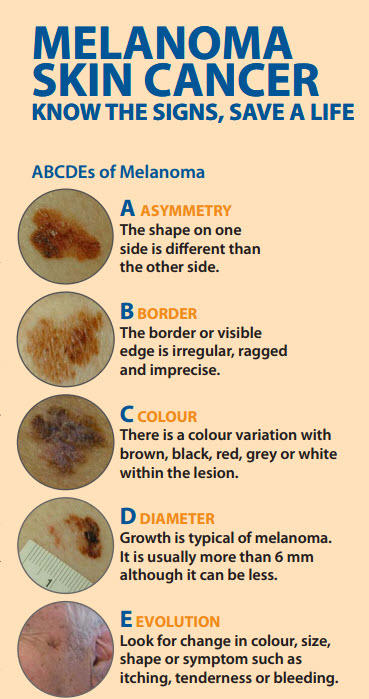Mole Patrol? I thought you said ‘Snow Patrol’
by Sara Chow
 Image credit: Canadian Dermatology Association
Image credit: Canadian Dermatology AssociationSince summer music festivals are now in full swing, many of us will be jamming outside in the sunshine. Although we know that sunscreen is important, let’s face it, sometimes we forget to reapply it. Prevention is the best way to avoid skin cancer, but early detection is also helpful if you know what to look for.
Skin cancer may seem like something we only read about, but it is a very common cancer. In fact, skin cancer is the most commonly diagnosed cancer worldwide, and in Canada, it is the third most common cancer diagnosed in women between 15 and 29 years of age.
There are 3 main types of skin cancer. Malignant melanoma is the most serious type, and is responsible for most deaths from skin cancer. The most common cause of skin cancer is overexposure of the skin to ultraviolet (UV) radiation – primarily from tanning beds and the sun.
Tanning beds have been on the public health naughty list for a long time and were recently regulated under Ontario’s Skin Cancer Prevention Act (Tanning Beds) which prohibits the sale, advertising and marketing of tanning beds to youth under 18 to help prevent skin cancer. We can’t regulate the sun, but we can limit our exposure by covering our arms and legs with loose-fitting lightweight clothing, wearing sunglasses and a hat, and applying broad spectrum sunscreen, with a minimum SPF of 15, and reapplying it (don’t forget!).
In addition to covering your skin, knowing the signs of skin cancer can be lifesaving. Remember the ‘ABCDEs of melanoma’:
- Asymmetry
-
- the shape on one side is different from the shape on the other side.
- Border
- the border or visible edge is irregular, ragged or imprecise.
- Colour
- there is a colour variation, with brown, black, red, grey or white within the lesion.
- Diameter
- growth is typical of a melanoma. It can measure more than 6 mm, although it can be less.
- Evolution
- look for changes in colour, size, shape or symptom such as itching, tenderness or bleeding.
Use these helpful tips to conduct a regular ‘mole patrol’ – yes, mole patrol – of your entire body, including your scalp and under your finger and toe nails. If you do have some suspicious looking moles, see your healthcare provider. They may refer you to a dermatologist for further investigation.
For more information on skin cancer, visit: www.dermatology.ca.